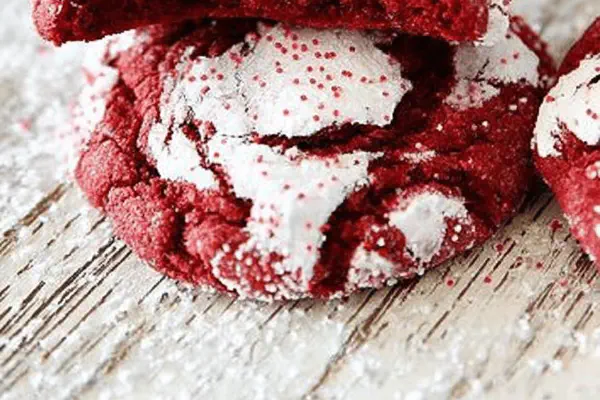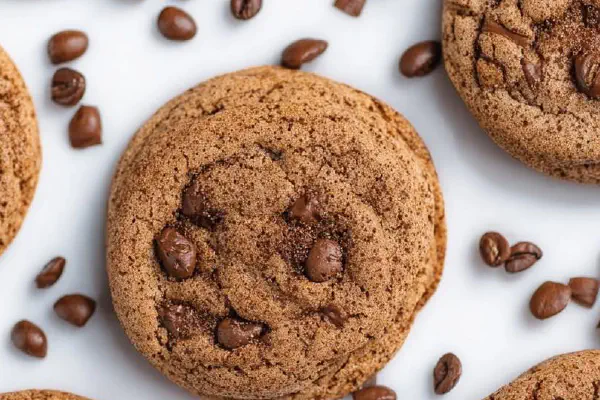Red Velvet Powdered Cookies

By Emma
Certified Culinary Professional
Ingredients
- 1 box red velvet cake mix (15.25 oz)
- 2/3 cup whipped topping (like Cool Whip), thawed
- 1 large egg
- 1 cup powdered sugar, plus more for coating
- Chocolate hearts or chips (optional, for topping)
About the ingredients
Method
===
- Heat oven to 320 degrees F, slightly lower than typical cookie heat. Line cookie sheet with silicone mat or parchment to prevent sticking and uneven browning.
===
- Combine in large bowl the cake mix, whipped topping, and egg. Use a sturdy spoon or sturdy spatula. Don’t overmix—lumps won’t hurt. Dough is sticky, tacky, almost too soft to roll; that’s right.
===
- Pour 1 cup powdered sugar in small bowl. Take heaping tablespoon of dough—cookie scoop helps beyond words—roll dough ball around in sugar until fully coated, almost dry. Place on sheet 2-3 inches apart; these spread little.
- Keep rolling and placing. If dough sticks to scoop, dust scoop with dry powdered sugar or coat with nonstick spray lightly.
===
- Bake 11 to 15 minutes. Listen for faint crackling sound, edges firming. Center looks set but soft. Color deepens, not burnt red but rich. Don’t overbake or they dry out.
- Remove pan, cool five minutes before adding chocolate heart center if using, so it gently melts slightly but not too much.
- Let cool completely before lifting with thin spatula or offset spatula. They’re fragile early on. Store airtight. Last several days but best first two.
- Repeat process till dough gone.
Cooking tips
Chef's notes
- 💡 Mix just till all ingredients combine; lumps okay. Overmix means tough, dryer crumb. Sticky dough normal, helps sugar stick well; dust scoop with powdered sugar for clean release. If too soft, refrigerate dough balls briefly. Roll dough balls in powdered sugar small batches keeps coating dry and crackled, prevents spread too much while baking.
- 💡 Lower oven to 320 degrees; hotter burns edges fast while center underbakes. Listen for faint crackle, edges firming, center still soft. Smell is big indicator too—rich cocoa with slight sweet tang signals readiness. Remove early if unsure; cookies finish firming while cooling, avoiding dry cracks.
- 💡 Use silicone mat or parchment for even bake. Prevents overbrowning bottoms, eases removal. Tried oil instead of whipped topping once—greasy, changes texture and flavor noticeably. Whipped topping keeps moisture but avoids soggy bottom. Real whipped cream possible but watch dough consistency carefully.
- 💡 Chocolate heart or chips pressed onto cookies only after cooling five minutes on pan; melts slightly but keeps form. Press too soon melts chocolate into dough, loses shape. Store cookies airtight, layer with parchment paper. Keeps crackled sugar intact, stops them turning chewy or sticky outside.
- 💡 Adjust cake mix flavors for variation but egg is binding must-have. No egg yields crumbly mess. Substitutions like cream cheese change texture noticeably; tested but not preferred. Powdered sugar critical in coating; regular sugar won’t cling or crackle properly. Keep dough dry enough for rolling but not stiff.
Common questions
What if dough is too sticky to roll?
Dust scoop and hands with powdered sugar. Chill dough balls briefly if still mushy. Sticky is right but too sticky means toss in fridge few minutes. Sugar coating helps handle dough better, don’t skip.
Can I swap whipped topping for something else?
Real whipped cream doable but dough can get runny. Tried oil but oily taste ruins cookie. Cream cheese changes texture and crumb, softer, denser. Experiment with caution; moisture content affects spread and bake time.
Cookies spreading too much?
Check sugar coating thickness; too little coating means more spread. Also dough temp affects spread—warm dough flattens. Chill balls if needed. Oven temp too high can speed spread then burn edges before set.
How to store cookies properly?
Air-tight container necessary for crackle texture. Layer cookies with parchment in between or sugar crust softens. Room temp fine a few days; longer keep cool and dry. Refrigerate makes them cakey, lose crisp top.



